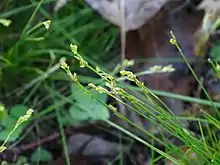| Carex eburnea | |
|---|---|
 | |
| Scientific classification | |
| Kingdom: | Plantae |
| Clade: | Tracheophytes |
| Clade: | Angiosperms |
| Clade: | Monocots |
| Clade: | Commelinids |
| Order: | Poales |
| Family: | Cyperaceae |
| Genus: | Carex |
| Subgenus: | Carex subg. Carex |
| Section: | Carex sect. Albae |
| Species: | C. eburnea |
| Binomial name | |
| Carex eburnea | |
Carex eburnea, known as ivory sedge,[1] ebony sedge,[2] and bristleleaf or bristle-leaved sedge,[3][4][5] is a small and slender sedge native to North America, from Alaska and Newfoundland south to central Mexico (San Luis Potosí and Querétaro).[6]
Description

Ivory sedge is a clump-forming sedge that spreads gradually by slender, light brown rhizomes to form colonies.[1] It has narrow leaves, 0.2 to 1 mm (0.008 to 0.039 in) wide and 3 to 21 cm (1 to 8 in) long, that grow from the base of the plant and alternately on the culms (stems). The culms are longer than the leaves, 7 to 31 cm (2+3⁄4 to 12+1⁄4 in) long.[7] The bases of the leaves and culms are wrapped in a light brown sheath. The leaves dry up after the growing season and persist at least until the next spring. [1]
Each inflorescence (flower cluster), at the end of a culm, has one staminate (male) spike above two to three pistillate (female) spikes, each enclosed at the base by a tubular bract.[1] There are 3 to 10 florets in each pistillate spike. The scales under the florets are white and translucent.
Pollinated florets produce three-sided[1] seeds (achenes) that are glossy blackish-brown when ripe, 1.5–2.2 mm (0.059–0.087 in) long by 0.7–1.1 mm (0.028–0.043 in) wide.[5] The stem of the inflorescence and the stems of the pistillate spikes are very short at blooming time, but lengthen a great deal by the time the seed matures, so that the clusters of achenes overtop the withered staminate spike and the stem is always longer than the leaves.[1]
Distribution and habitat
Ivory sedge usually grows in coniferous or mixed woodlands, sometimes in fens, stable dunes, or alvar (shallow soil above limestone).[7] It prefers sandy or gravelly soil with a neutral to alkaline pH.[1]
References
- 1 2 3 4 5 6 7 Chayka, Katy; Dziuk, Peter (2016). "Carex eburnea (Ivory Sedge)". Minnesota Wildflowers.
- ↑ Weakley, Alan S. (2018), Flora of the Southern and Mid-Atlantic States, working draft of 20 August 2018, University of North Carolina Herbarium, North Carolina Botanical Garden, University of North Carolina at Chapel Hill
- ↑ USDA, NRCS (n.d.). "Carex eburnea". The PLANTS Database (plants.usda.gov). Greensboro, North Carolina: National Plant Data Team. Retrieved 26 August 2016.
- ↑ "Carex eburnea". Native Plant Database. Lady Bird Johnson Wildflower Center, University of Texas at Austin. Retrieved 26 August 2016.
- 1 2 "Carex eburnea (bristle-leaved sedge)". Go Botany. New England Wildflower Society.
- ↑ "Carex eburnea". Germplasm Resources Information Network. Agricultural Research Service, United States Department of Agriculture. Retrieved 2018-08-01.
- 1 2 Ball, Peter W. (2002). "Carex eburnea". In Flora of North America Editorial Committee (ed.). Flora of North America North of Mexico (FNA). Vol. 23. New York and Oxford: Oxford University Press – via eFloras.org, Missouri Botanical Garden, St. Louis, MO & Harvard University Herbaria, Cambridge, MA.
External links
- Carex eburnea in the CalPhotos photo database, University of California, Berkeley
